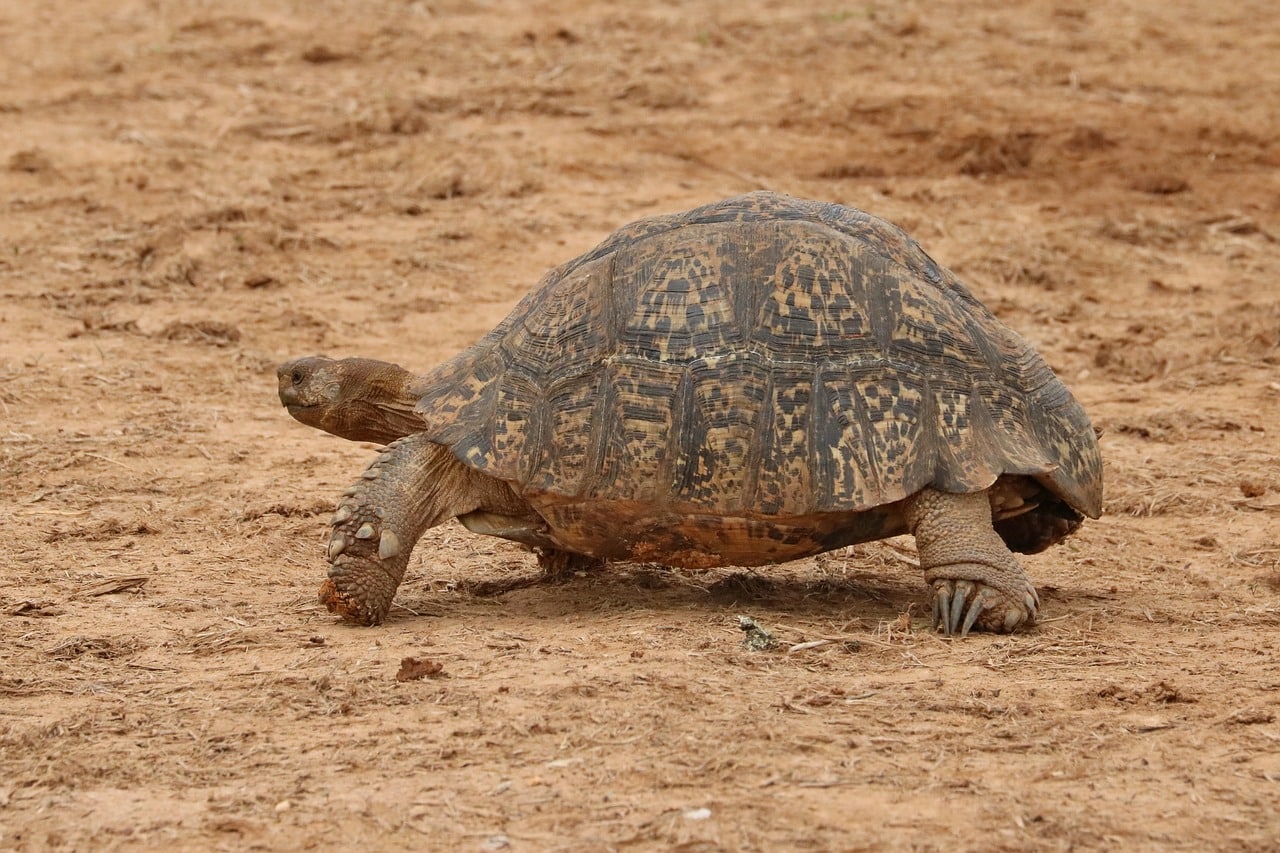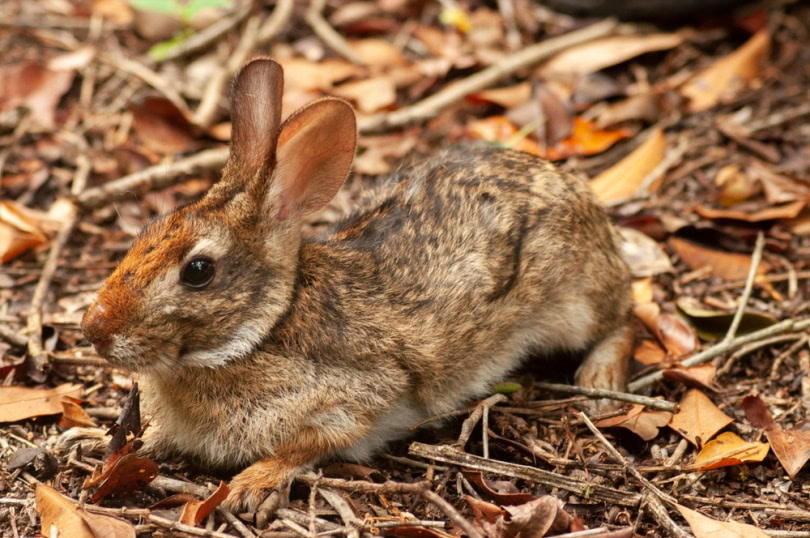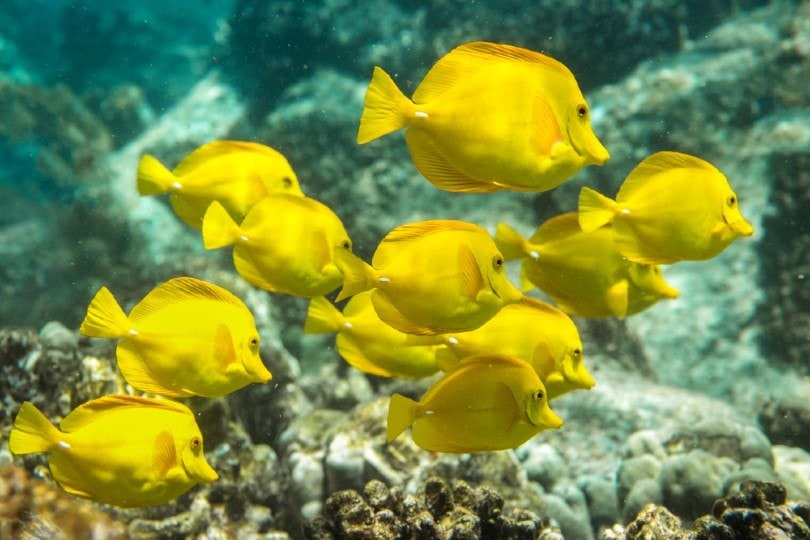Click to Skip Ahead
If you’re looking to bring home a laidback reptile with a fancy fresh shell, the leopard tortoise might have caught your eye. Before you get too excited, though, know that this tortoise can get massive, so they might not work for your living situation.
However, if you have the time and space, you can make quite an exciting setup for your reptile pal. These personable creatures will form long-lasting bonds with their owners—and sometimes outlive them too. Read on to find out more about leopard tortoises!

Quick Facts About the Leopard Tortoise
| Species Name: | Stigmochelys pardalis |
| Family: | Tortoise |
| Care Level: | Experienced |
| Temperature: | 75 to 85 degrees Fahrenheit |
| Temperament: | Docile, social |
| Color Form: | Yellow, black, brown |
| Lifespan: | 80 to 100 years |
| Size: | Up to 30 pounds |
| Diet: | Herbivore |
| Minimum Tank Size: | 6’ x 4’ x 1.5’ |
| Tank Setup: | Outdoor living |
| Compatibility: | Experienced owners |
Leopard Tortoise Overview
The breathtaking leopard tortoise is a giant reptile that inhabits Central and Southern Africa. You can find them plentifully in the wild, but they are also widespread in the pet trade industry.
These tortoises get quite large, so having an outside enclosure is the absolute best thing for them. Most people won’t have the proper room to house these creatures, which it’s essential to know before committing to the purchase of one.
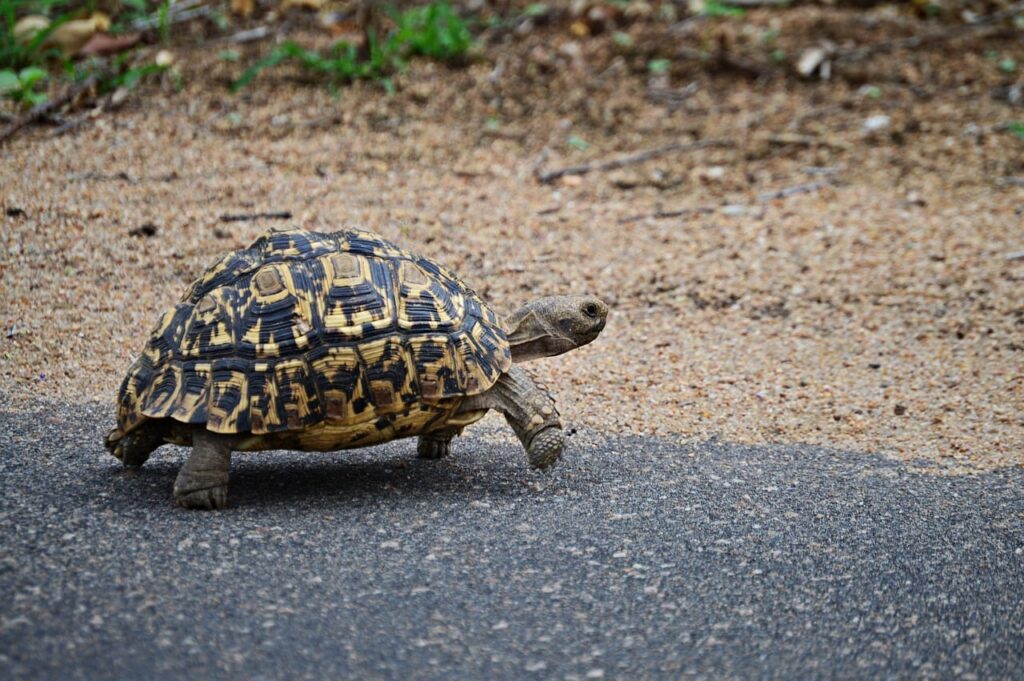
How Much Does a Leopard Tortoise Cost?
Leopard tortoises typically cost several thousand dollars, but even at the end of the scale, they still aren’t cheap. Leopard tortoises can cost anywhere from $350 to $5,000 and beyond. It will greatly depend on the breeder and the age and quality of the animal.
- Related Read: How to Take Care of a Pet Tortoise
Typical Behavior & Temperament
Many owners would agree that the leopard tortoise is surprising with their amazingly unique personality. Some can be extraordinarily amiable and social, while others are calmer and more reserved. It just depends on the individual.
When living together, these tortoises tend to get along. However, some males might show aggression during the mating season, which is less typical of domesticated leopard tortoises.
Tortoises have no external ears, and they use vibrations to navigate their surroundings. They also have an incredible sense of smell. They benefit from grazing, so if you have ample space, they will gladly munch on grasses.
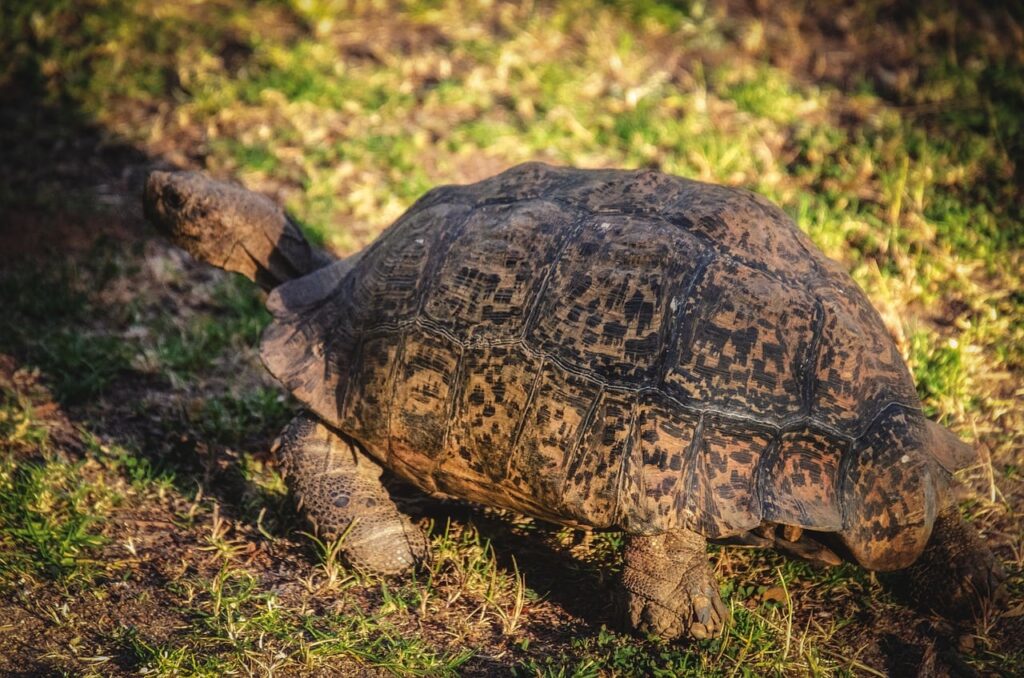
Appearance & Varieties
Leopard tortoises have thick shells that vary from yellow to black in color. As their name implies, the markings on the outside resemble those of a wild leopard cat. Each design varies from tortoise to tortoise.
Unlike many other animals, female leopard tortoises are larger than their male counterparts. Females reach 30 pounds or more, while males are roughly half that size. Although only one leopard tortoise is recognized, there seem to be two subspecies: the Stigmochelys pardalis babcocki and the Stigmochelys pardalis pardalis.
Adults are hard to tell apart, but hatchlings have a certain number of black spots on their scute to help distinguish them.

How to Take Care of a Leopard Tortoise
Creating the proper space for your turtle to roam is the key to their happiness. When you keep a unique creature like the leopard tortoise, you want to make sure their environment is completely safe and efficient.
Here are the care requirements that you will need to meet when you own one of these gorgeous reptiles.
Habitat, Tank Conditions & Setup
Enclosure
When possible, it’s always best to keep the leopard tortoise outdoors. Due to their large size, having an indoor enclosure can be nearly impossible for most owners. They simply get too large, which is hard to accommodate.
But don’t worry—securing an area for them won’t be as hard as you might think. You simply need a warm, dry place away from excessive moisture and inclement weather.
For one leopard tortoise, the enclosure should be at least 6’ x 4’ x 1.5’. Your turtle is hefty, so you must make the barrier tortoise-proof. There can be no spots where they can push through.
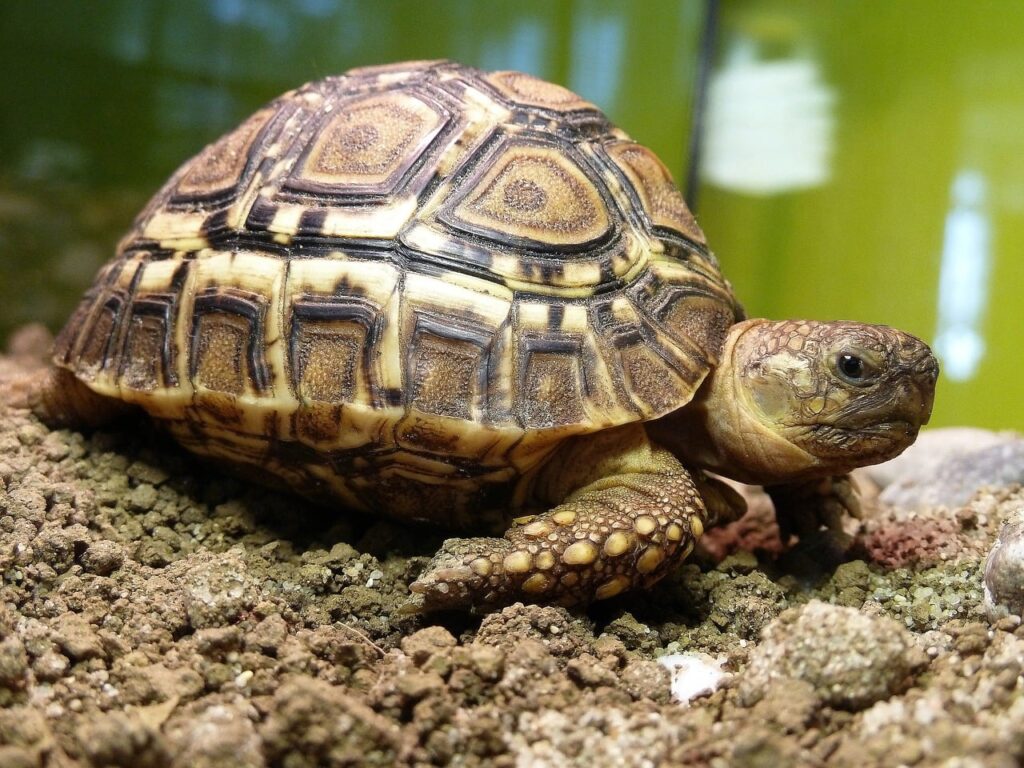
Substrate
You have a few options for the substrate. Many owners prefer a topsoil and sand mixture. You can also use grasses, hay, or cypress bark. Each works efficiently in the habitat.
If you allow your tortoise to roam around outside, they will love the natural terrain. Just be sure the conditions aren’t too wet or sloppy, as they are sensitive to excess moisture.
Temperature
Your leopard turtle will require two temperature ranges in their cage: warm and cool. The warm side of the cage should be a basking area, providing temperatures up to 95 degrees Fahrenheit. The cool side of the enclosure should be between 80 and 85 degrees Fahrenheit.
If you live in an area with cold winters, you will need to make a space for your tortoise to keep warm during these months. Since these creatures are so susceptible to respiratory infections, make sure there is no draft.
Lighting
Your tortoise should be exposed to a light that mimics sunlight for 12 hours per day. At night, you can turn it off to set day/night cycles. If your tortoise is outdoors, regular daytime and nighttime hours will suffice.

Do Leopard Tortoises Get Along With Other Pets?
Leopard turtles are docile creatures that get along and even form relationships with other pets. But there are two sides to this. While many of these reptiles love having a partner in crime, whether that be a dog, cat, or another creature, is it safe?
In most cases, it’s perfectly okay to have your tortoise around other pets. They are hardy with protected shells and sizable bodies. But while they can’t get injured easily, they may become stressed, scared, or wounded if another animal is too hyper or invasive. Make sure to supervise all interactions.

What to Feed Your Leopard Tortoise
Leopard tortoises love their greens! These herbivores can’t get enough delicious leafy greens, hay, and weeds. They need lots of fiber in their daily diet, so provide generous portions.
- Leafy greens
- Succulents
- Clover
- Honeysuckle
- Parsley
- Bell peppers
- Carrot
- Kale
- Dandelion
These animals may also require additional supplements to keep them healthy, such as calcium. Always check with your veterinarian before putting additives into their diet.
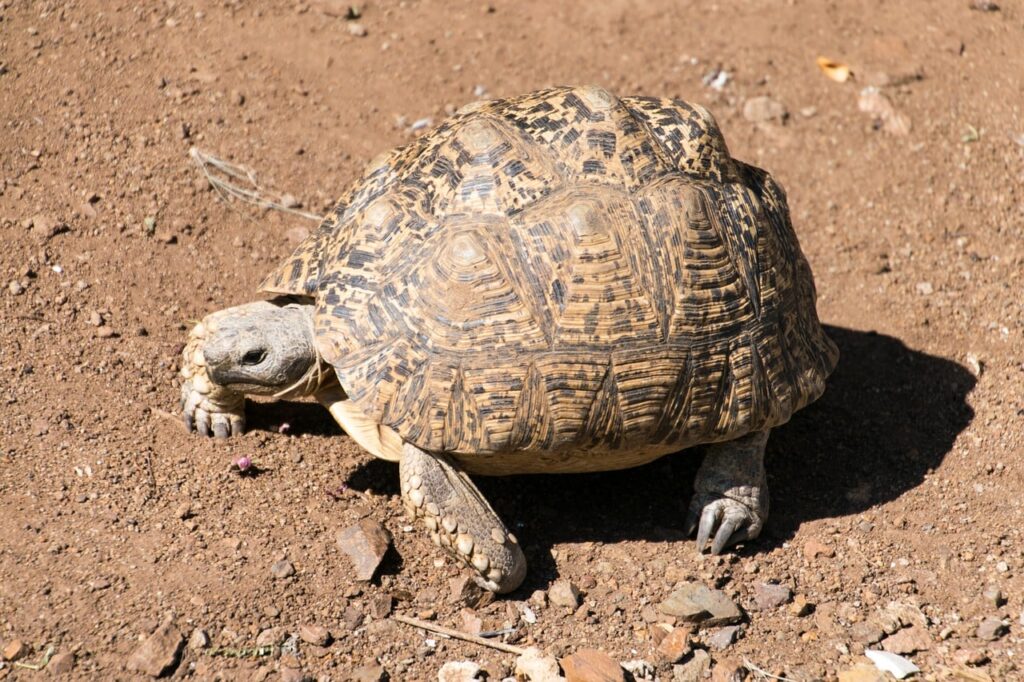
Keeping Your Leopard Tortoise Healthy
Your leopard tortoise needs proper care, including vetting. It is crucial to find an exotic veterinarian near you. This big reptile needs annual vet care along with any problems that may arise.
While these tortoises are generally healthy, they can run into a few health issue, including:
- Respiratory disease
- Constipation
- Pneumonia
- Parasites
- Impaction
If you notice any behavioral or physical changes in your leopard tortoise, take them to the vet right away. Many issues can be resolved with proper treatment.

Breeding
If you plan to breed, you might want to know just how easy it is. While it does take time, resources, and patience, it is possible for you to do it at home.
Tortoises reach sexual maturity between 6 and 8 years of age. So, if you’re thinking of breeding and your tortoise is still relatively young, you’ll have to wait. Tortoises must be sexually active for an entire year until fertilization is possible.
If you have a male and female together, the process can occur naturally, but you have to incubate the fertilized eggs. You will need to incubate the eggs at 84 degrees Fahrenheit for 60 days.
On average, leopard tortoise females produce one to seven clutches per year.

Conclusion: Is a Leopard Tortoise Suitable for You?
Due to their massive size and maintenance requirements, the leopard tortoise won’t work for everyone. But if you can make the space, they can be an extremely rewarding backyard buddy.
Remember that your tortoise needs the works: lots of space, proper living conditions, and an adequate diet. If you give them the right conditions, they may very well outlive you!
Featured Image Credit: Pixabay
